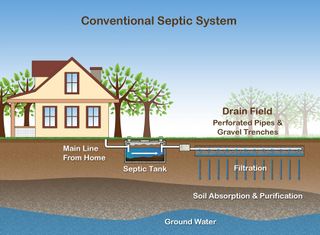Septic System
Many homeowners rely on septic systems for safe and effective treatment of their wastewater. Household wastewater is treated by a septic system before it filters into the soil. Recycled water from a septic system can help replenish groundwater supplies; however, if the system is not working properly, it can contaminate nearby waterbodies.
Groundwater and surface water runoff flows into streams, lakes, and coastal waters. If this water contains contaminants, they can make their way into surface waters, causing eutrophication It’s important to keep surface waters healthy to use for recreation, fishing, and as a drinking water source.
How a Septic System Works
Septic systems are underground wastewater treatment structures, commonly used in rural areas without centralized sewer systems. They use a combination of nature and proven technology to treat wastewater from household plumbing produced by bathrooms, kitchen drains, and laundry.
A typical septic system consists of a septic tank and a drainfield, or soil absorption field.
The septic tank digests organic matter and separates floatable matter (e.g., oils and grease) and solids from the wastewater. Soil-based systems discharge the liquid (known as effluent) from the septic tank into a series of perforated pipes buried in a leach field, chambers, or other special units designed to slowly release the effluent into the soil.
Alternative systems use pumps or gravity to help septic tank effluent trickle through sand, organic matter (e.g., peat and sawdust), constructed wetlands, or other media to remove or neutralize pollutants like disease-causing pathogens, nitrogen, phosphorus, and other contaminants. Some alternative systems are designed to evaporate wastewater or disinfect it before it is discharged to the soil.
Septic System Owners
Approximately 20 percent of homes in the United States use septic systems that locally treat their wastewater. When a septic system is improperly managed, elevated nitrogen and phosphorus levels can be released into local water bodies or ground water. An estimated 10 to 20 percent of septic systems fail at some point in their operational lifetimes. Common causes of septic system failure include aging infrastructure, inappropriate design, overloading with too much wastewater in too short a period of time and poor maintenance.[1]
Homeowners are responsible for maintaining their septic systems in most cases. To protect and maintain their system, homeowners should:
- Have their system inspected regularly and pump their tank as necessary
- Use water efficiently
- Not dispose of household hazardous waste (chemicals and medicines) in sinks or toilets
- Avoid driving vehicles or placing heavy objects on their drainfield
Septic System Failure Signs
A foul odor is not always the first sign of a malfunctioning septic system. Call a septic professional if you notice any of the following:
- Wastewater backing up into household drains.
- Bright green, spongy grass on the drainfield, especially during dry weather.
- Pooling water or muddy soil around your septic system or in your basement.
- A strong odor around the septic tank and drainfield.
Septic System Effects
Bathrooms and Kitchens - Wastewater from toilets, sinks, showers, and other appliances contains harmful bacteria, viruses, and nutrients that could contaminate nearby surface water sources. You can help reduce the amount of nutrients in your wastewater by limiting use of the garbage disposal and using phosphate-free detergents. Avoid flushing other chemicals or medications down the drain or toilet since they could also contaminate surface water sources.
Septic Tank - Wastewater generated in your home exits through a drainage pipe and into a septic tank. The septic tank is a buried, water-tight container that holds wastewater for separation and treatment. The solids settle to the bottom (sludge) and fats, oil and grease float to the top (scum). Microorganisms act to break down the sludge and destroy some of the contaminants in the wastewater. Your septic tank should be serviced and pumped on a regular basis to make sure it’s working properly.
Drainfield -The drainfield is a shallow, covered trench made in the soil in your yard. Partially treated wastewater from the septic tank flows out through the drainfield, filters down through the soil and enters the groundwater. If the drainfield is overloaded with too much liquid or clogged with solids, it will flood and cause sewage to surface in your yard or back up into your home.
Wastewater Treatment in Soil - Filtering wastewater through the soil removes most bacteria and viruses (also known as pathogens) and some nutrients. While soil can treat many contaminants, it cannot remove all of them (e.g., medicines, cleaning products, other potentially harmful chemicals). If untreated wastewater surfaces in the yard, wastewater may contaminate the streams, lakes, or coastal waters near your home. Avoid putting chemicals or medications down the drain or toilet since they could end up in surface waters too.
Groundwater - The water below the water table is called groundwater. Groundwater flowing underneath a drainfield captures any remaining contaminants released from the septic system. A stream, lake, or coastal water is at greater risk of becoming contaminated if it is in the path of groundwater flow beneath the septic system.

